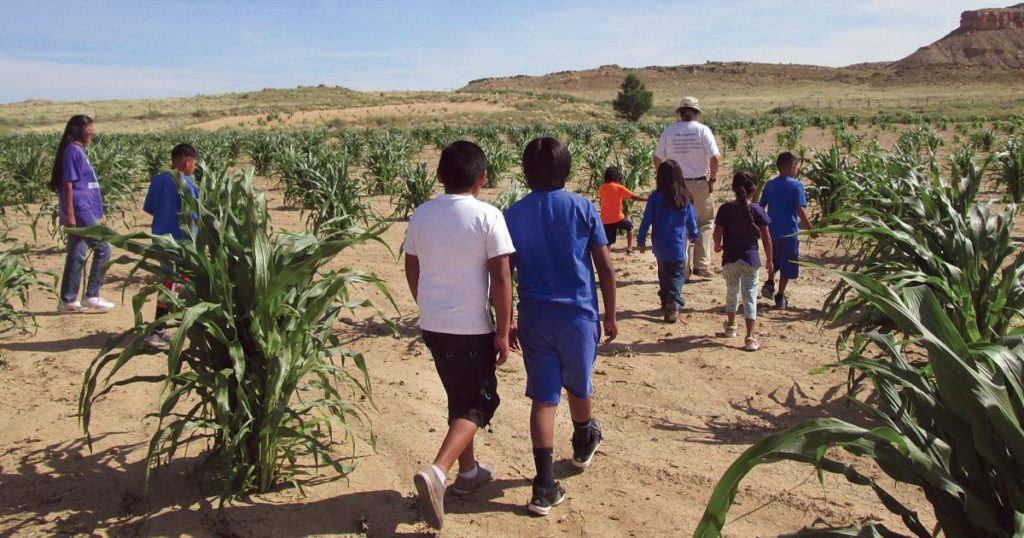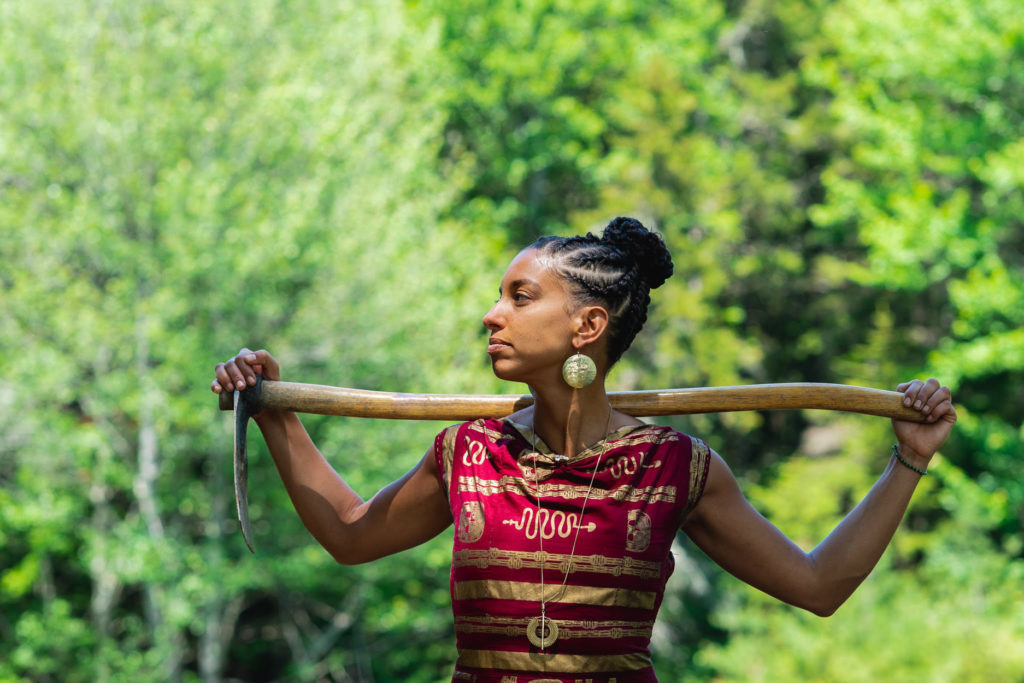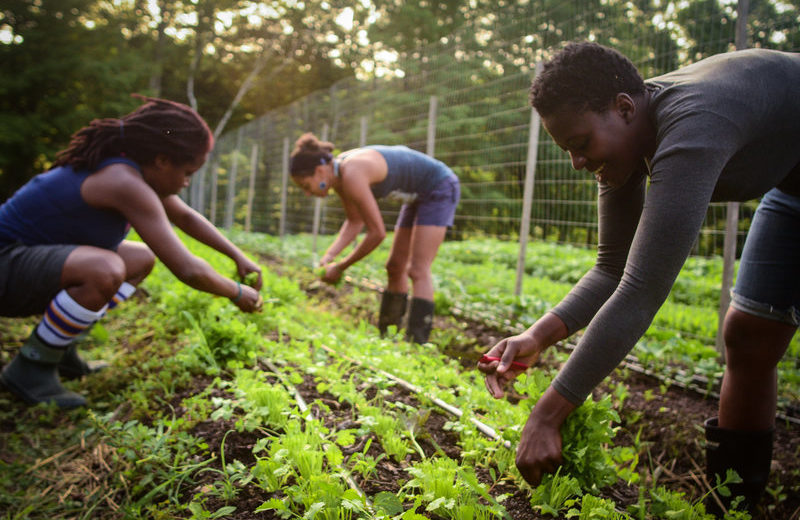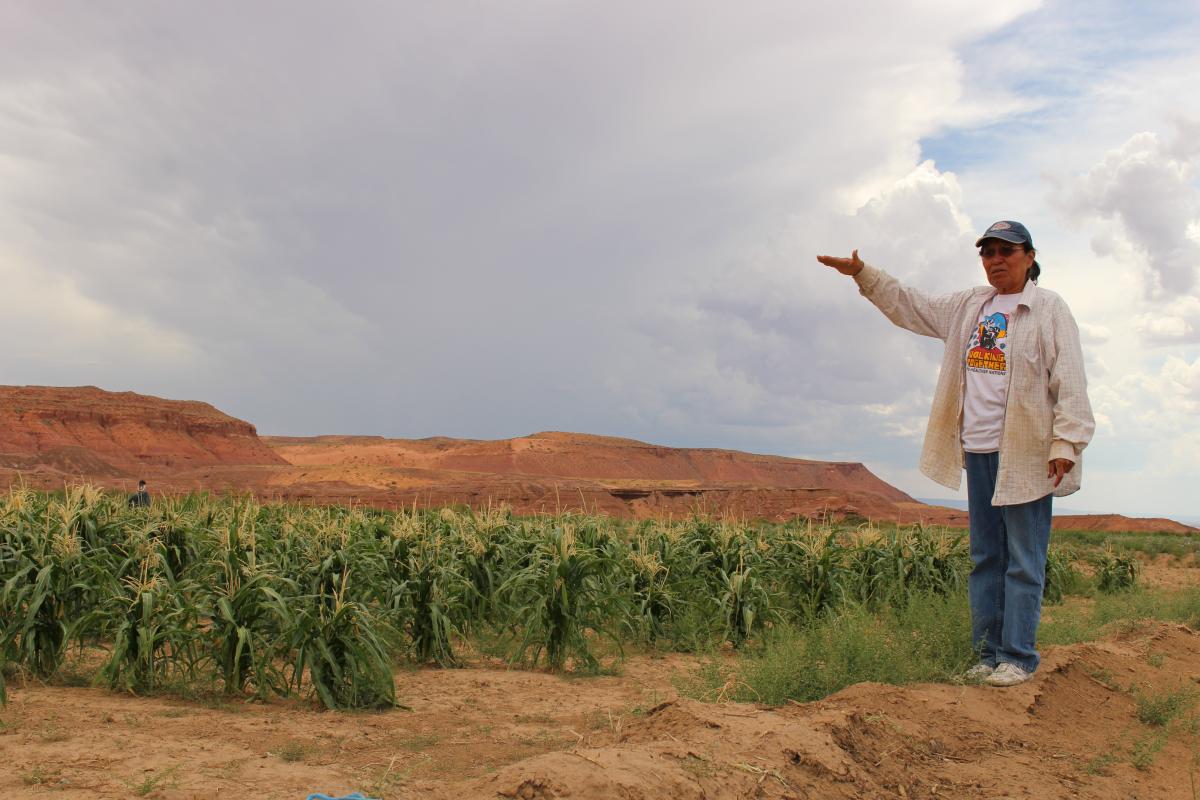Above: Hopi dryland
My initial understanding of sustainability stemmed from my experience of interning at a small-scale, organic farm for a summer. I looked at agriculture sustainability strictly through the lens of soil health and regeneration. However, when I talked with my friend, Kate Hamman, whose career started and continues to grow in agriculture, farmer advocacy, and land rights, my understanding of sustainability expanded.
“ It’s really a broad word for ‘health’,” Kate explained. As we talked, I learned how the history of ecological sustainability in our country is complicated and lacks certain voices (sound familiar?). I was drawn to this checkered narrative and the implications of filling in the gaps for our food system and the future of farmland.

It’s holy work to grow your own food.
I learned from Kate about the one-sided history of sustainable farming and how its history impacts the narrative that continues today in the fight against climate change. To begin, we have to look at the perceived value of farming in American history. Up until WWI, farming was generally seen as degraded or low brow work, which changed when growing one’s own food, like “victory gardens”, was encouraged by the government as an act of patriotism because it helped prevent food shortages during the wartime. It was more so a moral imperative or noble act, in spite of the fact that for centuries, people in other countries grew their own food simply to survive. Beginning in the 1960s, there was the “back to the land” phenomenon, a growing movement where young people, sickened by urban woes and 9 to 5 jobs, emigrated from cities and created rural communities. They romanticized the simplicity and holiness of the homestead lifestyle.
Kate mentioned how, “People were driven by a John Muir-type philosophy: nature is church and it’s holy work to grow your own food and eat organically.”
This ideology also helped give rise to organic agriculture, which picked up steam during the 1970s; consumers became more aware of the use of synthetic fertilizers (which lead to higher crop yield) and practices threatening the longevity of soil health. In 1990, rules and regulations around what comprises organic farming and the certification process began and weren’t fully implemented until 2002. Sustainable farming eventually grew into the fervent movement that it is today, especially as science about climate change has entered the public sphere.
Most people are compelled by the moral narrative around ecological sustainability- combatting political evils by individual action.
Documentaries on Netflix, detailed white papers, industry experts, nonprofits, and more are banded together to fuel a more sustainable future for American farming. These efforts and leaders are often white people, and invariably there are certain critical elements of this larger picture of sustainable farming that are missing.
“Most people are compelled by the moral narrative around ecological sustainability- combatting political evils by individual action. There’s a huge missing part of that narrative – marginalized communities have never had the opportunity to live “the moral lifestyle” on a farm,” Kate explained to me.
In terms of small scale agriculture, Kate has observed that, “morality is more of a driver than practical outcomes.” She added that “there have been communities on this continent using very sustainable agricultural practices for centuries.” I was curious to learn more about the sustainable practices that these cultures have been using long before 1970.
Working with the Land, Not Against It
Indigenous agriculture practices tend to stem from a connection between culture and the land indigenous people occupy. Native American tribes created food practices that responded to their local environment and ultimately were implemented to work with natural processes, not against them. Across Native American culture, The Three Sisters is a well known example of working with the natural environment. The Three Sisters are corn, beans, and squash which are grown together (companion planting) in order to feed and protect the soil while controlling pests.
The Hopi tribe of northeastern Arizona are known for their dryland farming, which is conducive to the desert climate where they live. In surrounding communities, they’re actually seen as models for how to farm during the increasing effects of climate change. Dryland farming uses less water by not relying on irrigation, and the farmers are dedicated to keeping any sort of weeds away from their crops, as they threaten to rob the soil of its moisture. The Hopi people also plant their crops in favorable soil that have good moisture to begin with.

The Hopi grow their corn in clumps of six, spaced far apart, to conserve water and protect the corn from wind damage. They use planting sticks and put 10 to 12 seeds in a hole, which yield about 12 plants; the best six of the corn plants will continue to grow. An incredible aspect of the Hopi culture is the longevity of their crops and seeds. They continue to grow 12 varieties of corn that have been sustained for thousands of years.
The Lesser Known History of Organic Farming
Leah Penniman, co-executive director of Soul Fire Farm, a BIPOC-centered farm community in upstate New York that’s dedicated to ending racism and justice in today’s food system, powerfully recounted aspects of organic farming’s missing history.

She said, “I began to see how miseducated I had been regarding sustainable agriculture. I learned that “organic farming” was an African-indigenous system developed over millennia and first revived in the United States by a Black farmer, Dr. George Washington Carver, of Tuskegee University in the early 1900s.” Carver did research on the use of crop rotation in combination with nitrogen-fixing legumes, learning how to regenerate soil biology. He developed these regenerative agriculture methods which helped farmers avoid using monocultures and renew the health of their soil.
Penniman went on to explain the true history of CSA, or community shared agriculture. CSA today is a system in which a farm sells shares of their harvest to the community and then provides produce on a weekly basis over the course of a season. Dr. Booker T. Whatley, also of Tuskegee University, was one of the innovators of CSA, though at the time he called it a “Clientele Membership Club.” In addition to calling for “pick-your-own” operations that produced a diverse set of crops annually, he also developed a system that allowed consumers to buy produce that was 40% cheaper than the supermarket rate.

Reconsidering the story
While efforts to regenerate farmland and reduce the effects of climate change are of course great things for our earth, I wonder if the power of these efforts lies entirely in its current leaders. Do some of the ground-breaking solutions lie in marginalized communities who have been farming for centuries? If we give African American and Native American cultures their rightful place in the sustainability narrative, could this lead to the environmental change that is desperately needed? Something tells me this inclusion in the story would lead to less moralizing and to more practical outcomes.
Resources
https://the-journal.com/articles/15212
https://sustainablefoodcenter.org/latest/gardening/indigenous-agriculture-and-sustainable-food
https://www.eomega.org/article/the-untold-history-of-black-farming






I don’t think the title of your article matches the content lol. Just kidding, mainly because I had some doubts after reading the article.
Rely on BWER Company for superior weighbridge solutions in Iraq, offering advanced designs, unmatched precision, and tailored services for diverse industrial applications.
Your article helped me a lot, is there any more related content? Thanks! https://www.binance.com/ar-BH/register?ref=V2H9AFPY
you are in reality a just right webmaster The site loading velocity is incredible It seems that you are doing any unique trick In addition The contents are masterwork you have performed a wonderful task on this topic
Hello Neat post Theres an issue together with your site in internet explorer would check this IE still is the marketplace chief and a large element of other folks will leave out your magnificent writing due to this problem
Hey, Jack here. I’m hooked on your website’s content – it’s informative, engaging, and always up-to-date. Thanks for setting the bar high!
My cousin suggested this website to me, and I’m uncertain if this post was written by him since no one else seems to know the specifics of my issue. You’re incredible. Thank you!
Can you be more specific about the content of your article? After reading it, I still have some doubts. Hope you can help me.
Hey there You have done a fantastic job I will certainly digg it and personally recommend to my friends Im confident theyll be benefited from this site
Wow wonderful blog layout How long have you been blogging for you make blogging look easy The overall look of your site is great as well as the content
Hello i think that i saw you visited my weblog so i came to Return the favore Im trying to find things to improve my web siteI suppose its ok to use some of your ideas
Excellent blog here Also your website loads up very fast What web host are you using Can I get your affiliate link to your host I wish my web site loaded up as quickly as yours lol
I loved as much as you will receive carried out right here The sketch is attractive your authored material stylish nonetheless you command get got an impatience over that you wish be delivering the following unwell unquestionably come more formerly again since exactly the same nearly a lot often inside case you shield this hike
Thanks for sharing. I read many of your blog posts, cool, your blog is very good. https://www.binance.info/id/join?ref=V3MG69RO
Thank you for your sharing. I am worried that I lack creative ideas. It is your article that makes me full of hope. Thank you. But, I have a question, can you help me?
I have read your article carefully and I agree with you very much. So, do you allow me to do this? I want to share your article link to my website: Sign Up